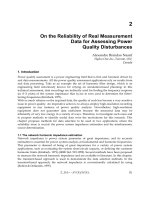Convection and Conduction Heat Transfer Part 5 doc
Bạn đang xem bản rút gọn của tài liệu. Xem và tải ngay bản đầy đủ của tài liệu tại đây (4.96 MB, 30 trang )
Convection and Conduction Heat Transfer
110
where the ratio between the Prandtl and the Rayleigh number is known as the Grashof
number
Ra
Gr=
Pr
T
. (18)
The de Vahl Davis benchmark is limited to the natural convection of the air in a rectangular
cavity with aspect ratio
R
A1
=
and Pr 0.71.
=
In this work additional tests are done for
lower Prandtl number and higher aspect ratio in order to test the method in regimes similar
to those in the early stages of phase change simulations of metal like materials where the
oscillatory “steady-state” develops.
2.2 Porous media natural convection
A variant of the test, where instead of the free fluid, the domain is filled with porous media,
is considered in the next test. Similar to the de Vahl Davis benchmark test, the porous
natural convection case is also well known in the literature (Chan, et al., 1994, Jecl, et al.,
2001, Ni and Beckermann, 1991, Prasad and Kulacky, 1984, Prax, et al., 1996, Raghavan and
Ozkan, 1994, Šarler, et al., 2000, Šarler, et al., 2004a, Šarler, et al., 2004b) and therefore a good
quantitative comparison is possible.
The only difference from de Vahl Davis case is in the momentum equation, and the
consecutive velocity boundary conditions. Instead of the Navier-Stokes the Darcy
momentum equation is used to describe the fluid flow in the porous media
() P
tK
μ
ρρ
∂
+
∇⋅ =−∇ − +
∂
v
vv v b
, (19)
where K stands for permeability. The main difference in the momentum equation is in its
order. The Navier-Stokes equation is of the second order while the Darcy equation is of the
first order and therefore different boundary conditions for the velocity apply. Instead of the
no-slip boundary condition for velocity, the slip and impermeable velocity boundary
conditions are used. This is formulated as
(
)
,0t
Γ
⋅
=vp n . (20)
Instead of the thermal Rayleigh and Prandtl numbers, the filtration Rayleigh number
defines
()
Ra
T
the problem
()
2
Ra =
TH C H
p
F
KTT c
βρ
λμ
−Ωg
. (21)
2.3 Phase change driven by natural convection
The benchmark test is similar to the previous cases with an additional phase change
phenomenon added. The solid and the liquid thermo-physical properties are assumed to be
equal. In this case the energy transport is modelled through enthalpy (h) formulation. The
concept is adopted in order to formulate a one domain approach. The phase change
phenomenon is incorporated within the enthalpy formulation with introduction of liquid
fraction (f
L
). The problem is thus defined with equations (1), (2), (4) and
Numerical Solution of Natural Convection Problems by a Meshless Method
111
()
()
h
hT
t
ρρ λ
∂
+∇⋅ =∇⋅ ∇
∂
v
, (22)
()
L
p
hT cT
f
L=+, (23)
with
;1
() ;
;0
FL
F
LFLF
L
F
TT T
TT
fT T T TT
T
TT
δ
δ
δ
⎧
≥+
⎪
−
⎪
=+>>
⎨
⎪
⎪
≤
⎩
. (24)
The phase change of the pure material occurs exactly at the melting temperature which
produces discontinues in the enthalpy field due to the latent heat release. The constitutive
relation (24) incorporates a smoothing interval near the phase change in order to avoid
numerical instabilities.
Fig. 2. The pure phase change test schematics
The boundary conditions are set to
(
)
,0t
Γ
=
vp
, (25)
(
)
0, 1
x
Tp t
=
=
, (26)
(
)
1, 0
xF
Tp t T
=
==
, (27)
(
)
(
)
0, 1, 0
yy
yy
Tp t Tp t
pp
∂
∂
=
===
∂∂
, (28)
and initial state to
(
)
,00t
Ω
=
=vp
, (29)
Convection and Conduction Heat Transfer
112
(
)
,00Tt
Ω
=
=p
. (30)
Velocity in the solid state is forced to zero by multiplying it with the liquid fraction. This
approach introduces additional smoothing in the artificial “mushy” zone. This smoothing
produces an error of the same magnitude as smoothing of the enthalpy jump at the phase
change temperature. The problem is schematically presented in Figure 2.
Additional dimensionless number to characterize the ratio between the sensible and latent
heat, the Stefan number, is introduced
(
)
Ste=
p
HC
cT T
L
−
. (31)
3. Solution procedure
There exist several meshless methods such as the Element free Galerkin method, the
Meshless Petrov-Galerkin method, the point interpolation method, the point assembly
method, the finite point method, the smoothed particle hydrodynamics method, the
reproducing kernel particle method, the Kansa method (Atluri and Shen, 2002a, Atluri and
Shen, 2002b, Atluri, 2004, Chen, 2002, Gu, 2005, Kansa, 1990a, Kansa, 1990b, Liu, 2003), etc.
However, this chapter is focused on one of the simplest classes of meshless methods in
development today, the Radial Basis Function (Buhmann, 2000) Collocation Methods
(RBFCM) (Šarler, 2007). The meshless RBFCM was used for the solution of flow in Darcy
porous media for the first time in (Šarler, et al., 2004a). A substantial breakthrough in the
development of the RBFCM was its local formulation, LRBFCM. Lee at al. (Lee, 2003)
demonstrated that the local formulation does not substantially degrade the accuracy with
respect to the global one. On the other hand, it is much less sensitive to the choice of the RBF
shape and node distribution. The local RBFCM has been previously developed for diffusion
problems (Šarler and Vertnik, 2006), convection-diffusion solid-liquid phase change
problems (Vertnik and Šarler, 2006) and subsequently successfully applied in industrial
process of direct chill casting (Vertnik, et al., 2006).
In this chapter a completely local numerical approach is used. The LRBFCM spatial
discretization, combined with local pressure-correction and explicit time discretization,
enables the consideration of each node separately from other parts of computational
domain. Such an approach has already been successfully applied to several thermo-fluid
problems (Kosec and Šarler, 2008a, Kosec and Šarler, 2008b, Kosec and Šarler, 2008c, Kosec
and Šarler, 2008d, Kosec and Šarler, 2009) and it shows several advantages like ease of
implementation, straightforward parallelization, simple consideration of complex physical
models and CPU effectiveness.
An Euler explicit time stepping scheme is used for time discretization and the spatial
discretization is performed by the local meshfree method. The general idea behind the local
meshless numerical approach is the use of a local influence domain for the approximation of
an arbitrary field in order to evaluate the differential operators needed to solve the partial
differential equations. The principle is represented in Figure 3.
Each node uses its own support domain for spatial differential operations; the domain is
therefore discretized with overlapping support domains. The approximation function is
introduced as
Numerical Solution of Natural Convection Problems by a Meshless Method
113
1
() ()
Basis
N
nn
n
θα
=
=Ψ
∑
pp, (32)
where
,,and
Basis n n
N
θα
Ψ
stand for the interpolation function, the number of basis
functions, the approximation coefficients and the basis functions, respectively. The basis
could be selected arbitrarily, however in this chapter only Hardy’s Multiquadrics (MQs)
()
(
)
(
)
2
/1
nn
nC
σ
Ψ
=−⋅− +ppppp , (33)
with σ
C
standing for the free shape parameter of the basis function, are used. By taking into
account all support domain nodes and equation (32), the approximation system is obtained.
In this chapter the simplest possible case is considered, where the number of support
domain nodes is exactly the same as the number of basis functions. In such a case the
approximation simplifies to collocation. With the constructed collocation function an
arbitrary spatial differential operator (
L) can be computed
()
1
()
Basis
N
nn
n
LL
θα
=
=Ψ
∑
pp
. (34)
In this work only five node support domains are used and therefore a basis of five MQs is
used as well.
Fig. 3. The local meshless principle
The implementation of the Dirichlet boundary condition is straightforward. In order to
implement Neumann and Robin boundary conditions, however, a special case of interpolation
is needed. In these boundary nodes the function directional derivative instead of the
function value is known and therefore the equation in the interpolation system changes to
1
()
Basis
N
BC n n
n
α
=
∂
Θ= Ψ
∂
∑
p
n
, (35)
in the Neumann boundary nodes and to
1
() ()
Basis
N
BC n n n
n
ab
α
=
∂
⎛⎞
Θ= Ψ +Ψ
⎜⎟
∂
⎝⎠
∑
pp
n
, (36)
in the Robin boundary nodes.
Convection and Conduction Heat Transfer
114
With the defined time and spatial discretization schemes, the general transport equation
under the model assumptions can be written as
()
2
10
00 00
DS
t
θθ
θθρ
−
=
∇−∇⋅ +
Δ
v , (37)
where
0,1 0
,, andDt S
θ
Δ stand for the field value at current and next time step, general
diffusion coefficient, time step and for source term, respectively.
To couple the mass and momentum conservation equations a special treatment is required.
The intermediate velocity (
ˆ
v
) is computed by
()
()
00 0000
ˆ
()
t
P
μρ
ρ
Δ
=+ −∇+∇⋅∇+−∇⋅vv v b vv
. (38)
The equation (38) did not take in account the mass continuity. The pressure and the velocity
corrections are added
1
ˆˆ
mm+
=
+vvv
1
ˆˆ
mm
PPP
+
=
+
, (39)
where , andmv P
stand for pressure velocity iteration index, velocity correction and
pressure correction, respectively. By combining the momentum and mass continuity
equations the pressure correction Poisson equation emerges
2
ˆ
m
t
P
ρ
Δ
∇⋅ = ∇v
. (40)
Instead of solving the global Poisson equation problem, the pressure correction is directly
related to the divergence of the intermediate velocity
2
ˆ
m
P
t
ρ
=
∇⋅
Δ
v
A
, (41)
where
A stands for characteristic length. The proposed assumption enables direct solving of
the pressure velocity coupling iteration and thus is very fast, since there is only one step
needed in each node to evaluate the new iteration pressure and the velocity correction. With
the computed pressure correction the pressure and the velocity can be corrected as
11
ˆˆ
ˆˆ
and
mm m m
t
PPPP
ζ
ζ
ρ
++
Δ
=− ∇ =+vv
, (42)
where
ζ
stands for relaxation parameter. The iteration is performed until the criterion
ˆ
·
V
ε
∇<v is met in all computational nodes.
4. Results
The results of the benchmark tests are assessed in terms of streamfunction
(
)
Ψ
, cavity
Nusselt number
(
)
Nu and mid-plane velocity components.
()
1
0
()
x
y
vd
p
ψ
=
∫
pp
, (43)
Numerical Solution of Natural Convection Problems by a Meshless Method
115
()
Nu( ) ( ) ( )
x
x
T
vT
p
∂
=− +
∂
p
ppp
. (44)
The Nusselt number is computed locally on five nodded influence domains, while the
streamfunction is computed on one dimensional influence domains each representing an
x
row, where all the nodes in the row are used as an influence domain. The streamfunction is
set to zero in south west corner of the domain
(
)
0,0 0
ψ
=
.
The de Vahl Davis test represents the first benchmark test in the series and therefore some
additional assessments regarding the numerical performance as well as the computational
effectiveness are done. One of the tests is focused on the global mass continuity
conservation, which indicates the pressure-velocity coupling algorithm effectiveness. The
global mass leakage is analysed by implementing
avg avg avg
1
avg
1
() () ;(0)
()
D
N
n
D
n
t
tt t t t
N
Nt
ρ
ρρ ρ ρ
ρρρ
=
+
Δ= +Δ ∇⋅ = =
Δ= − Δ
∑
v
, (45)
where
avg
,and
D
N
ρ
ρ
Δ
stand for average density, number domain nodes and density
change.
The pressure-velocity coupling relaxation parameter
ζ
is set to the same value as the
dimensionless time-step in all cases. The reference values in the Boussinesq approximation
are set to the initial values.
4.1 De Vahl Davis test
The classical de Vahl Davis benchmark test is defined for the natural convection of air
(Pr 0.71= ) in the square closed cavity (
R
A1
=
). The only physical free parameter of the test
remains the thermal Rayleigh number. In the original paper (de Vahl Davis, 1983) de Vahl
Davis tested the problem up to the Rayleigh number
6
10 , however in the latter publications,
the results of more intense simulations were presented with the Rayleigh number up to
8
10
.
Lage and Bejan (Lage and Bejan, 1991) showed that the laminar domain of the closed cavity
natural convection problem is roughly below
9
Gr<10 . It was reported (Janssen and Henkes,
1993, Nobile, 1996) that the natural convection becomes unsteady for
8
Ra 2 10=⋅
. This section
deals with the steady state solution and therefore regarding to the published analysis, a
maximum
8
Ra 10
T
= case is tested.
A comparison of the present numerical results with the published data is stated in Table 1
where the
mid
(0.5,0.5)
ψψ
=
,
av
g
Nu ,
max
(0.5, )
x
y
v
p
and
max
(,0.5)
xy
vp
stand for mid-point
streamfunction, average Nusselt number and maximum mid-plane velocities, respectively.
The results of the present work are compared to the (de Vahl Davis, 1983) (a), (Sadat and
Couturier, 2000) (b), (Wan, et al., 2001) (c) and (Šarler, 2005) (d). The specifications of the
simulations are stated in Table 2.
The temperature contours (yellow-red continuous plot) and the streamlines are plotted in
Figure 4 with the streamline contour plot step 0.05 for
3
Ra=10 , 0.2 for
4
Ra=10 , 0.5 for
5
Ra=10 , 1 for
6
Ra=10 , 1.5 for
7
Ra=10 and 2.5 for
8
Ra=10 . The Nusselt number time
development is plotted in Figure 5 in order to characterize the system dynamics.
Due to the completely symmetric problem formulation (
(
)
,00.5Tt
Ω
==p
) the cold side and
the hot side average Nusselt numbers should be the same at all times and therefore the
Convection and Conduction Heat Transfer
116
difference between the two can be understood as a numerical error of the solution
procedure. A simple relative error measure is introduced as
(
)
(
)
()
avg avg
max
Nu 1, Nu 0,
E=
Nu
x
y
x
y
p
ppp=− =
p
, (46)
where
avg
max
Nu and Nu stand for average and maximum Nusselt number. The Nusselt
number as a function of time is presented in Figure 5. The hot-cold side errors
(
)
E are
plotted in Figure 6 and the mid-plane velocities are presented in Figure 7.
Fig. 4. Temperature and streamline contour plots for de Vahl Davis benchmark test
Numerical Solution of Natural Convection Problems by a Meshless Method
117
Ra
max
x
v
y
p
max
y
v
x
p
av
g
Nu
mid
ψ
reference /
D
N
3.679 0.179 3.634 0.813 1.116 1.174 (a)
3.686 0.188 3.489 0.813 1.117 (c)
3.566 3.544 1.165 (d)
3.991 0.170 3.931 0.825 1.101 1.298 1677
3.699 0.177 3.653 0.812 1.098 1.194 6557
3
10
3.695 0.179 3.645 0.820 1.089 1.196 10197
4
10
19.51 0.120 16.24 0.823 2.234 5.098 (a)
19.79 0.120 16,17 0.823 2.243 (c)
19.04 15.80 4.971 (d)
19.81 0.120 16.24 0.825 2.075 5.155 1677
19.83 0.120 16.27 0.825 2.120 5.167 6557
20.03 0.120 16.45 0.830 2.258 5.240 10197
5
10
68.22 0.066 34.81 0.855 4.510 9.142 (a)
68.52 0.064 34.63 0.852 4.534 9.092 (b)
70.63 0.072 33.39 0.835 4.520 (c)
67.59 32.51 8.907 (d)
67.65 0.070 33.67 0.850 4.624 8.896 1677
68.98 0.062 34.60 0.850 4.813 9.135 6557
69.69 0.069 35.03 0.860 4.511 9.278 10197
6
10
216.75 0.038 65.33 0.851 8.798 16.53 (a)
219.41 0.038 64.43 0.852 8.832 16.29 (b)
227.11 0.04 65.4 0.86 8.8 (c)
211.67 61.55 15.91 (d)
195.98 0.045 63.73 0.850 6.1 15.15 1677
219.48 0.038 64.87 0.851 7.67 16.13 6557
221.37 0.039 65.91 0.860 8.97 16.51 10197
7
10
687.43 0.023 145.68 0.888 16.59 28.23 (b)
714.48 0.022 143.56 0.922 16.65 (c)
632.60 0.020 127.70 0.925 10.43 24.93 1677
654.803 0.035 143.55 0.902 14.70 27.51 6557
687.20 0.021 149.61 0.900 16.92 28.61 10197
8
10
2180.1 0.011 319.19 0.943 30.94 50.81 (b)
2259.08 0.012 296.71 0.93 31.48 (c)
2060.86 0.010 264.96 0.939 29.33 44.85 6557
2095.23 0.009 278.49 0.930 32.12 47.12 10197
Table 1. A comparison of the results
Convection and Conduction Heat Transfer
118
Fig. 5. The Nusselt number as a function of time. The red plot stands for the domain average
and the blue for the cold side average Nusselt number
Numerical Solution of Natural Convection Problems by a Meshless Method
119
Fig. 6. The Nusselt number hot-cold side error as a function of time
Convection and Conduction Heat Transfer
120
1677 nodes 6557 nodes 10197 nodes
Ra
v
ε
t
Δ
[s]
c
t
Pv
N
t
Δ
[s]
c
t
Pv
N
t
Δ
[s]
c
t
Pv
N
/
ρ
ρ
Δ
3
10
10e-4 1e-04 6 3208 1e-4 26 26837 5e-05 65 3662 3.37e-7
4
10
10e-3 1e-04 5 3154 1e-4 15 3259 5e-05 51 3706 8.44e-6
5
10
10e-2 1e-te04 5 1590 1e-4 14 1244 5e-05 43 4090 1.06e-5
6
10
1 1e-04 4 5527 1e-4 14 5608 1e-05 283 144089 1.38e-4
7
10
5 1e-05 6 18250 1e-5 85 71340 5e-06 270 184697 3.01e-4
8
10
25 5e-6 192 193708 5e-06 387 219885 5.90e-4
Table 2. Numerical specifications with time and density loss analysis
Fig. 7. Velocity mid-plane profiles
Numerical Solution of Natural Convection Problems by a Meshless Method
121
4.2 Low Prandtl number - tall cavity test
The next test is merely a generalization of de Vahl Davis with the same governing equations,
initial state and boundary conditions, where the cold side of the domain is set to the initial
temperature. The tall cavity with aspect ratio
R
A1/4
=
is filled with metal like (Al-
4.5%Cu) low Prandtl fluid Pr 0.0137
=
at the Rayleigh number
5
Ra 2.81 10=⋅ is considered.
The case is especially interesting due to its oscillating »steady-state« which is a result of a
balance between the buoyancy and the shear forces. This case is also relevant for fluid flow
behaviour at initial stages of melting of low Prandtl materials (metals), since it has a similar
geometrical arrangement. The test case has been already computed by two different
numerical methods (Založnik
, et al., 2005) (spectral FEM and FVM) with good mutual
agreement. Respectively, these solutions have been used for assessment of the present
method as well.
The temperature contours and the streamlines are plotted as continuous red to yellow fill
and dotted lines with a contour step 0.2, respectively, in Figure 8.
Fig. 8. The early stage time development and “steady-state“ oscillations of a tall cavity
natural convection - streamline and temperature contour plots
A comparison with the already published data is done on the analysis of the hot side
Nusselt number time development
(
)
avg
Nu 0,
x
y
pp
=
. To confirm the agreement of the
results, the hot side Nusselt number frequency domains are compared, where the early
stages of signal development are omitted. From Figure 9 one can see that the agreement
with reference results is excellent. In Figure 9 the frequency domains for different node
distributions are compared, as well. The Nu
f
re
q
stands for Nusselt number transformation
to the frequency domain and
f
stands for dimensionless frequency.
The presented case is highly sensitive; even the smallest changes in the case setup affect the
results dramatically, for example, changing the aspect ratio for less than 1 % results in
completely different flow structure. Instead of two there are three major oscillating vortices.
On the other hand, the presented results are computed with the completely different
numerical approach in comparison with the reference solutions (meshless spatial
Convection and Conduction Heat Transfer
122
discretization against FVM and Spectral method, explicit against implicit time discretization
scheme and LPVC against SIMPLE pressure-velocity coupling) and still the comparison
shows a high level of agreement. The presented comparison infers on a high level of
confidence in the present novel meshless method and the local solution approach.
Fig. 9. The hot side average Nusselt number time development comparison
Fig. 10. The hot side average Nusselt number in the frequency domain
4.3 Porous media test
The next test is focused on the assessments of the solution procedure behaviour when
working with fluid flow in the Darcy porous media. Again, a symmetrical differentially
heated rectangular cavity is considered with impermeable velocity boundary condition.
Numerical Solution of Natural Convection Problems by a Meshless Method
123
F
Ra
R
A
max
x
v
max
y
v
av
g
Nu
mid
ψ
reference /
D
N
v
ε
tΔ
1.979 2.863 (a)
11.174 18.112 1.941 2.860 10197 0.01 1e-04
11.214 17.928 1.962 2.853 40397 0.01 1e-05
50
1
11.236 17.845 1.975 2.848 160797 0.01 1e-05
17.380 35.889 3.101 4.375 (a)
3.103 (b)
3.010 (c)
17.500 37.454 3.040 4.510 10197 0.1 1e-04
17.562 37.055 3.071 4.607 40397 0.1 1e-05
2
10
1
17.603 36.873 3.086 4.655 160797 0.1 1e-05
13.42 (b)
72.560 441.771 13.044 17.062 10197 1 1e-04
74.741 435.107 13.455 18.791 40397 1 1e-05
3
10
1
75.577 432.335 13.529 19.658 160797 1 1e-05
257.394 4946.968 36.720 35.436 10197 1 5e-05
287.375 4880.108 44.295 49.235 40397 5 5e-06
4
10
1
287.375 4880.197 44.295 49.310 160797 5 1e-06
2.135 2.148 (a)
50
0.5
16.562 23.402 2.130 2.090 20297 0.1 1e-04
2
10
0.5
27.109 52.136 3.720 3.509 20297 1 1e-05
3
10
0.5
120.724 732.806 22.452 15.928 20297 1 1e-05
1.386 2.639 (a)
50
2
7.039 11.710 1.367 2.608 20297 0.1 1e-05
2
10
2
10.779 23.283 11.944 4.630 20297 1 1e-05
3
10
2
45.111 241.218 7.250 19.576 20297 1 1e-05
Table 3. A comparison of the results and numerical parameters
Three different aspect ratios are tested A
R
= [0.5,1,2] for filtration Rayleigh numbers up to
10
4
. The results are compared against (a) (Šarler, et al., 2000), (b) (Ni and Beckermann, 1991),
and (c) (Prax
, et al., 1996) with good agreement achieved (Table 3). In addition to the
previously treated cases in quoted works, results for Ra
F
= 10
3
and Ra
F
= 10
4
are newly
represented in this work. The pressure-velocity coupling algorithm was tested for up to
160797 uniformly distributed nodes and it behaves convergent. The temperature and the
Convection and Conduction Heat Transfer
124
streamfunction contours are presented in Figure 11 for tall cavity, Figure 12 for low cavity
and Figure 13 for square cavity with streamline steps 2, 5, 15 and 40 for Ra
F
= 50, Ra
F
= 10
2
,
Ra
F
= 10
3
and Ra
F
= 10
4
, respectively. Additional comparison of the results with reference
Finite Volume Method (FVM) solution, previously used in (Šarler
, et al., 2000) for mid-plane
velocities, hot side Nusselt number, mid-plane and top temperature profiles is done for case
with A
R
= 1 and filtration Rayleigh number Ra
F
= 100 (Figure 14). The comparison shows
good agreement with the generally accepted solution.
Fig. 11. Temperature and streamline contour plots for the test with
R
A1/2
=
Fig. 12. Temperature and streamline contour plots for the test with,
R
A2
=
Numerical Solution of Natural Convection Problems by a Meshless Method
125
Fig. 13. Temperature and streamline contour plots for the test with
R
A1
=
Convection and Conduction Heat Transfer
126
Fig. 14. A comparison of cross-sections quantities. The mid-plane velocities, the mid-plane
and top temperatures and hot side Nusselt number, respectively
Fig. 15. Temperature and streamline contour plots for pure melting benchmark test
Numerical Solution of Natural Convection Problems by a Meshless Method
127
Fig. 16. The average liquid fraction as a function of time
4.4 Melting
All computations are performed on the 10197 uniformly distributed nodes with the pressure-
velocity relaxation parameter set to the same numerical value as the time-step. The organic-
like (high Prandtl Number) and metal-like (low Prandtl number) materials are subjected to
the melting simulation in order to assess the method. The benchmark cases definitions
together with the global mass continuity check and time-steps are presented in Table 4. The
reference values in the Boussinesq approximation are set to the initial values. A comparison
of the results or demonstration for all four cases is done at specific dimensionless time
C
t
,
stated in Table 4, unless stated otherwise. The streamfunction and temperature contour
plots are shown in Figure 15 with streamline steps: 0.1, 0.5 and 4.0 for
Cases 1,2 and 3,4,
respectively. The phase change front comparison is demonstrated in Figure 17.
The average liquid fraction (
av
g
L
f ) time development for all four cases are presented in
Figure 16 and the hot side average Nusselt number
(
)
avg
Nu ( 0, )
xy
p
p=
in Figure 18.
Additional node distribution convergence analysis is done for the
Case 1 at time
10
t =
. The
results are presented for phase change front and mid-plane temperature profile in Figure 19.
For mid-plane velocity profiles the results are shown in Figure 20. In Figure 21 the average
cavity temperature
(
)
av
g
T
and liquid fractions
(
)
av
g
L
f as a function of the number of
computational nodes shown. The results confirm convergent behaviour in all analyses.
Pr Ste Ra
t
Δ
/
C
t
ρ
ρ
Δ
C
t
Case 1 0.02 0.01 2.5e4 1.0e-5 1.74e-6 10
Case 2 0.02 0.01 2.5e5 5.0e-6 8.02e-6 10
Case 3 50 0.1 1.0e7 1.0e-4 2.58e-5 0.1
Case 4 50 0.1 1.0e8 1.0e-5 1.31e-8 0.1
Table 4. The benchmark test definition
Convection and Conduction Heat Transfer
128
Fig. 17. The phase change front position comparison
Fig. 18. The hot side average Nusselt number as a function of time
Numerical Solution of Natural Convection Problems by a Meshless Method
129
Fig. 19. The phase change front position (left) and mid-plane temperature (right) profile for
Case 1 as a function of different discretizations at 10t =
Fig. 20. The mid-plane velocities profiles for
Case 1 as a function of different discretizations
at
10
t =
Fig. 21. The cavity average temperature (left) and cavity average liquid fraction (right) as a
function of domain nodes count
Convection and Conduction Heat Transfer
130
5. Conclusions
In this chapter it is shown that the proposed numerical method as well as the proposed
solution procedure performs well for the natural convection problems at different flow
constitutive relations and regimes.
A detailed analysis of the de Vahl Davis test has been performed in order to assess the
method in details. The mass leakage test and the cold-hot side Nusselt number comparison
both confirmed that the method is accurate when such type of problems are considered.
Furthermore, a comparison with already published data shows good agreement as well. The
test involving a tall cavity, where the method is compared to the two completely different
approaches, gives excellent agreement in case of the oscillatory flow regimes. The time
average hot side Nusselt number development shows good quantitative comparison with
the benchmark data. To complete the tests, the natural convection in a Darcy momentum
regime is performed. Again, good agreement with the published data is achieved.
The final test is the phase change driven by a natural convection. The present results show
good agreement with other approaches in terms of interphase boundary dynamics and
complicated flow structures despite the simplest LRBFCM implementation. The Nusselt
number oscillations in the
Case 2 were already reported by Mencinger (Mencinger, 2003).
The oscillations are a result of an unstable flow regime in the low Prandtl fluid, similar as in
the tall cavity natural convection case, where the periodic solutions occur. The potential
instabilities can occur in the natural convection in liquid metals, due to their low Prandtl
number (Založnik
, et al., 2005, Založnik and Šarler, 2006). Complex flow patterns and fast
transients can occur already in laminar regimes at relatively low Rayleigh numbers. With
another words; lowering the Prandtl number increases the nonlinearity of the natural
convection. Generally, the main sources of instabilities for all presented cases stems from
nonlinearities due to the complex liquid flow pattern and enthalpy behaviour at the phase
change interphase. The enthalpy jump problem is partly resolved by introducing numerical
smoothing of the phase change, at least enough to get stable results, but at the price of
physical model accuracy. A detailed discussion on the parameter range with appearance of
the flow physics based oscillations can be found in the work (Hannoun, et al., 2003). However,
the results are in good agreement with the already known solutions (Gobin and Le Quéré,
2000). There is a bit higher deviance in the
Case 4, still the deviations of other authors for
that case is very high and it is difficult to conclude which solution is more credible.
6. Acknowledgment
The authors would like to express their gratitude to Slovenian Research Agency for support
in the framework of the projects Young Researcher Programme 1000-06-310232 (G. K.) and
project P2-0379 (B. Š.).
7. References
Atluri, S. N. & Shen, S. (2002a), The Meshless Method, Tech Science Press, Encino.
Atluri, S. N. & Shen, S. (2002b), The meshless local Petrov-Galerkin (MLPG) method: a
simple & less-costly alternative to the finite element and boundary element
methods,
CMES: Computer Modeling in Engineering & Sciences, Vol. 3, pp. 11-52.
Atluri, S. N. (2004),
The Meshless Method (MLPG) for Domain and BIE Discretization, Tech
Science Press
, Forsyth.
Bejan, A. (2004),
Convection Heat Transfer John Wiley & Sons, New Jersey.
Numerical Solution of Natural Convection Problems by a Meshless Method
131
Buhmann, M. D. (2000), Radial Basis Functions, Cambridge University Press, Cambridge.
Chan, B. K. C.; Ivey, C. M. & Barry, J. M. (1994), Natural convection in enclosed porous
media with rectangular boundaries,
Wärme und Stoffübertragung, Vol. 7, pp. 22-30.
Chen, W. (2002), New RBF collocation schemes and kernel RBFs with applications,
Lecture
Notes in Computational Science and Engineering
, Vol. 26, pp. 75-86.
de Vahl Davis, G. (1983), Natural convection of air in a square cavity: a bench mark numerical
solution,
International Journal of Numerical Methods in Fluids, Vol. 3, pp. 249-264.
Divo, E. & Kassab, A. J. (2007), Localized meshless modeling of natural-convective viscous
flows,
Numerical Heat Transfer, Vol. B129, pp. 486-509.
Gobin, D. & Le Quéré, P. (2000), Melting from an isothermal vertical wall, synthesis of a
numerical comparison excercise,
Computer Assisted Mechanics and Engineering
Sciences
Vol. 198, pp. 289-306.
Gu, G.R. Liu; Y.T. (2005),
An Introduction to Meshfree Methods and Their Programming,
Springer
, Dordrecht.
Hannoun, N.; Alexiades, V. & Zee Mai, T. (2003), Resolving the controversy over tin and
gallium melting in a rectangular cavity heated from the side,
Numerical Heat
Transfer
Vol. B44, pp. 253-276.
Hong, C. P. (2004),
Computer Modelling of Heat and Fluid Flow Materials Processing, Institute of
Physics Publishing Bristol
.
Hortmann, M.; Perić, M. & Scheuerer, G. (1990), Finite volume multigrid prediction of
laminar natural convection - bench-mark solutions,
International Journal for
Numerical Methods in Fluids
, Vol. 11, pp. 189-207.
Janssen, R. J. A. & Henkes, R. A. W. M. (1993), Accuracy of finite-volume disretizations for
the bifurcating natural-convection flow in a square cavity,
Numerical Heat Transfer,
Vol. B24, pp. 191-207.
Jecl, R.; Škerget, L. & Petrešin, E. (2001), Boundary domain integral method for transport
phenomena in porous media,
International Journal for Numerical Methods in Fluids,
Vol. 35, pp. 35-59.
Kansa, E. J. (1990a), Multiquadrics - a scattered data approximation scheme with application
to computational fluid dynamics, part I,
Computers and Mathematics with
Applications
, Vol. 19, pp. 127-145.
Kansa, E. J. (1990b), Multiquadrics - a scattered data approximation scheme with application
to computational fluid dynamics, part II,
Computers and Mathematics with
Applications
, Vol. 19, pp. 147-161.
Kosec, G. & Šarler, B. (2008a), Solution of thermo-fluid problems by collocation with local
pressure correction,
International Journal of Numerical Methods for Heat and Fluid
Flow
, Vol. 18, pp. 868-882.
Kosec, G. & Šarler, B. (2008b), Convection driven melting of anisotropic metals,
International
Journal of Cast Metals Research
, Vol. 22, pp. 279-282.
Kosec, G. & Šarler, B. (2008c), Local RBF collocation method for Darcy flow,
CMES:
Computer Modeling in Engineering & Sciences
, Vol. 25, pp. 197-208.
Kosec, G. & Šarler, B. (2008d), Meshless aproach to solving freezing driven by a natural
convection,
Materials Science Forum, Vol. 649, pp. 205-210.
Kosec, G. & Šarler, B. (2009), Solution of phase change problems by collocation with local pressure
correction,
CMES: Computer Modeling in Engineering & Sciences, Vol. 47, pp. 191-216.
Lage, J. L. & Bejan, A. (1991), The Ra-Pr domain of laminar natural convection in an
enclosure heated from the side,
Numerical Heat Transfer, Vol. A19, pp. 21-41.
Lee, C.K.; Liu, X.; Fan, S.C. (2003), Local muliquadric approximation for solving boundary
value problems,
Computational Mechanics, Vol. 30, pp. 395-409.
Convection and Conduction Heat Transfer
132
Liu, G.R. (2003), Mesh Free Methods, CRC Press, Boca Raton.
Manzari, M. T. (1999), An explicit finite element algorithm for convection heat transfer problems,
International Journal of Numerical Methods for Heat and Fluid Flow, Vol. 9, pp. 860-877.
Mencinger, J. (2003), Numerical simulation of melting in two-dimensional cavity using
adaptive grid,
Journal of Computational Physics, Vol. 198, pp. 243-264.
Ni, J. & Beckermann, C. (1991), Natural convection in a vertical enclosure filled with
anisotropic porous media,
ASME Journal of Heat Transfer, Vol. 113, pp. 1033-1037.
Nobile, E. (1996), Simulation of time-dependent flow in cavities with the additive-correction
multigrid method, part II: Apllications,
Numerical Heat Transfer, Part B, Vol. 30, pp.
Prasad, V. & Kulacky, F. A. (1984), Convective heat transfer in a rectangular porous cavity.
Effect of aspect ratio on flow structure and heat transfer,
ASME Journal of Heat
Transfer
, Vol. 106, pp. 158-65.
Prax, C.; Sadat, H. & Salagnac, P. (1996), Diffuse approximation method for solving natural
convection in porous Media,
Transport in Porous Media, Vol. 22, pp. 215-223.
Raghavan, R. & Ozkan, E. A. (1994),
Method for computing unsteady flows in porous media, John
Wiley and Sond inc.
, Essex.
Sadat, H. & Couturier, S. (2000), Performance and accuracy of a meshless method for
laminar natural convection,
Numerical Heat Transfer, Vol. B37, pp. 455-467.
Šarler, B.; Gobin, D.; Goyeau, B.; Perko, J. & Power, H. (2000), Natural convection in porous
media - dual reciprocity boundary element method solution of the Darcy model,
International Journal of Numerical Methods in Fluids, Vol. 33, pp. 279-312.
Šarler, B.; Perko, J. & Chen, C. S. (2004a), Radial basis function collocation method solution
of natural convection in porous Media,
International Journal of Numerical Methods for
Heat & Fluid Flow
, Vol. 14, pp. 187-212.
Šarler, B.; Perko, J.; Gobin, D.; Goyeau, B. & Power, H. (2004b), Dual reciprocity boundary
element method solution of natural convection in Darcy-Brinkman porous media,
Engineering Analysis with Boundary Elements, Vol. 28, pp. 23-41.
Šarler, B. (2005), A radial basis function collocation approach in computational fluid
dynamics,
CMES: Computer Modeling in Engineering & Sciences, Vol. 7, pp. 185-193.
Šarler, B. & Vertnik, R. (2006), Meshfree explicit local radial basis function collocation
method for diffusion problems,
Computers and Mathematics with Applications, Vol.
51, pp. 1269-1282.
Šarler, B. (2007),
From global to local radial basis function collocation method for transport
phenomena
, Springer, Berlin, pp. 257-282.
Vertnik, R. & Šarler, B. (2006), Meshless local radial basis function collocation method for
convective-diffusive solid-liquid phase change problems,
International Journal of
Numerical Methods for Heat and Fluid Flow
, Vol. 16, pp. 617-640.
Vertnik, R.; Založnik, M. & Šarler, B. (2006), Solution of transient direct-chill aluminium
billet casting problem with simultaneous material and interphase moving
boundaries by a meshless method,
Engineering Analysis with Boundary Elements, Vol.
30, pp. 847-855.
Wan, D. C.; Patnaik, B. S. V. & Wei, G. W. (2001), A new benchmark quality solution for the
buoyancy-driven cavity by discrete singular convolution,
Numerical Heat Transfer,
Vol. B40, pp. 199-228.
Založnik, M.; Xin, S. & Šarler, B. (2005), Verification of a numerical model of
macrosegregation in direct chill casting,
International Journal of Numerical Methods
for Heat & Fluid Flow
, Vol. 18, pp. 308-324.
Založnik, M. & Šarler, B. (2006), "Thermosolutal flow in metals and implications for DC
casting",
Modeling of Casting, Welding and Advanced Solidification Processes XI.
6
Hydromagnetic Flow with Thermal Radiation
Cho Young Han
1
and Se-Myong Chang
2
1
Korea Aerospace Research Institute,
2
Kunsan National University,
Republic of Korea
1. Introduction
Magnetohydrodynamic (MHD) flows, which is the simplest plasma model, has been the
subject of a great number of empirical and theoretical investigations in many industrial
fields. Especially the MHD flows associating with heat transfer have received considerable
attention so far, as their applications reside in many industrial fields such as electric
propulsion for space exploration, crystal growth in liquids, cooling of nuclear reactors,
electronic packages, micro electronic devices, etc.
The most common type of body force, which acts on fluid, is attributed to gravity so that the
body force vector can be deduced from the gravitational acceleration. On the other hand,
when an electrically conducting fluid is subjected to a magnetic field, the fluid motion
induces an electric current such that the fluid velocity is reduced on account of interaction
between the electric current and the fluid motion. Therefore, in case of free convection of an
electrically conducting fluid in the presence of a magnetic field, there should be two body
forces, i.e., a buoyancy force and a Lorentz force. They interact with each other, and in turn
influence the transport phenomena of heat and mass.
Among various studies for MHD free flows, rather small amount of studies have been
accomplished for the confined enclosures. Seki et al. (1979) studied the laminar natural
convection of mercury subjected to a magnetic field parallel to gravity in a rectangular
enclosure. Numerical results were obtained and compared to their experiment in the
consideration of a partially heated vertical wall by a uniform heat generator. Rudraiah et al.
(1995) performed a numerical simulation about natural convection in a two-dimensional
cavity filled with an electrically conducting fluid in the presence of a magnetic field aligned
to gravity. They selected the Grashof and Hartmann numbers as controlling parameters to
examine the effect of a magnetic field on free convection and associated heat transfer. The
three-dimensional free convective flow in a cubical enclosure in the presence of a transverse
magnetic field was analysed by Kolsi et al. (2007) numerically.
For the free convection in an inclined enclosure under a magnetic field, the following
representative works have been conducted. Bian et al. (1996) have studied the effect of a
transverse magnetic field on buoyancy-driven convection in an inclined rectangular porous
cavity, saturated with an electrically conducting fluid. Recently Wang et al. (2007)
investigated numerically the natural convection in an inclined enclosure filled with porous
media when a strong magnetic field was applied. They modelled the cubic enclosure, such
that the direction of an applied magnetic field is varied in accordance with the inclination









